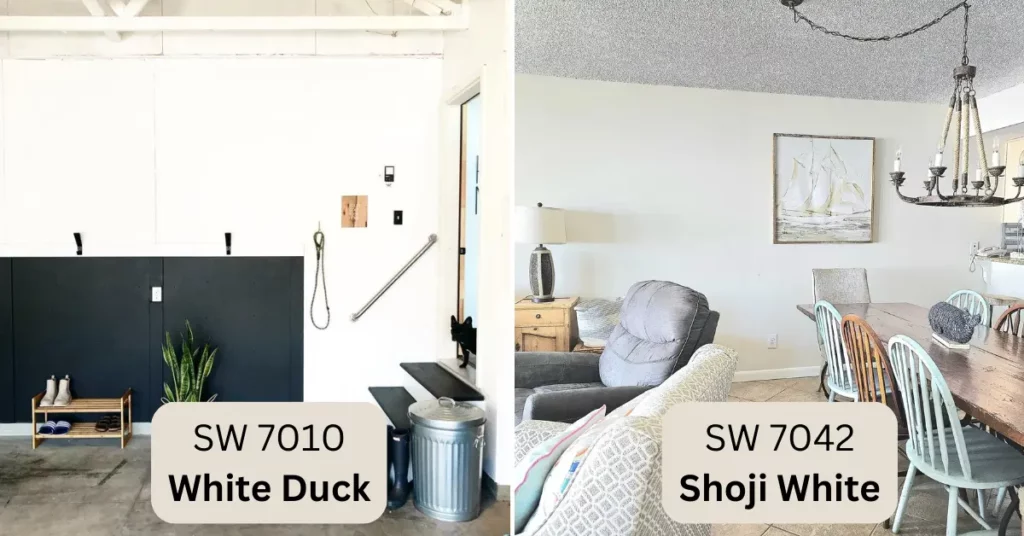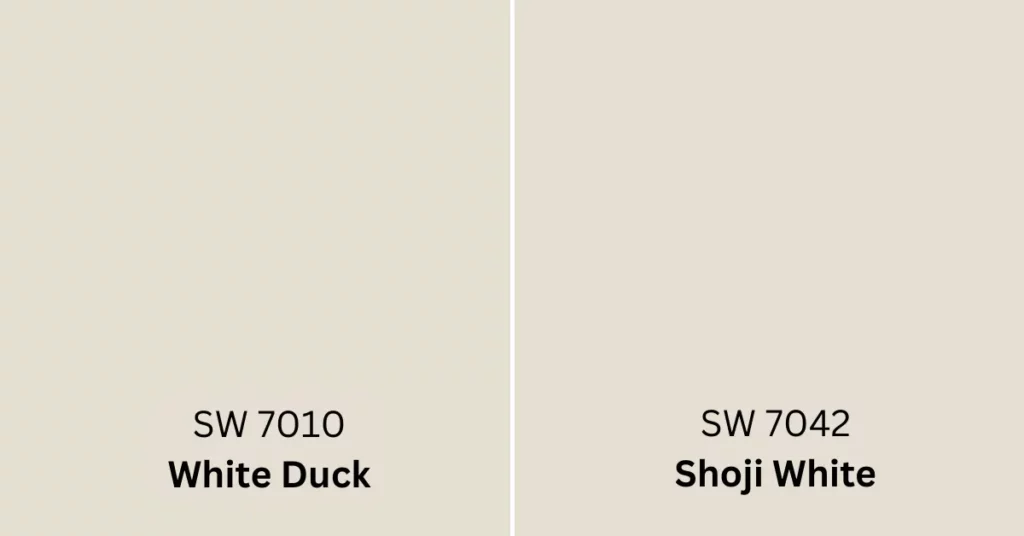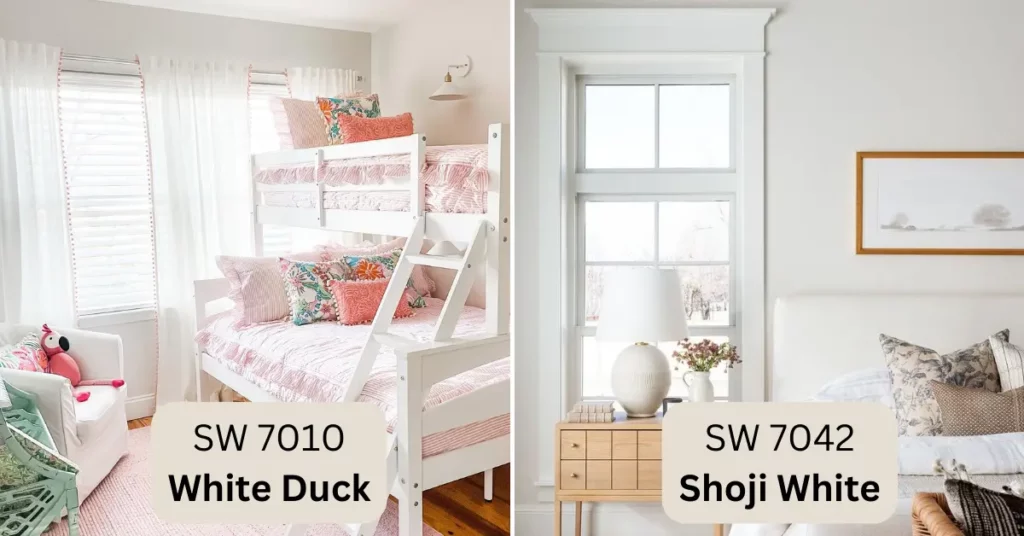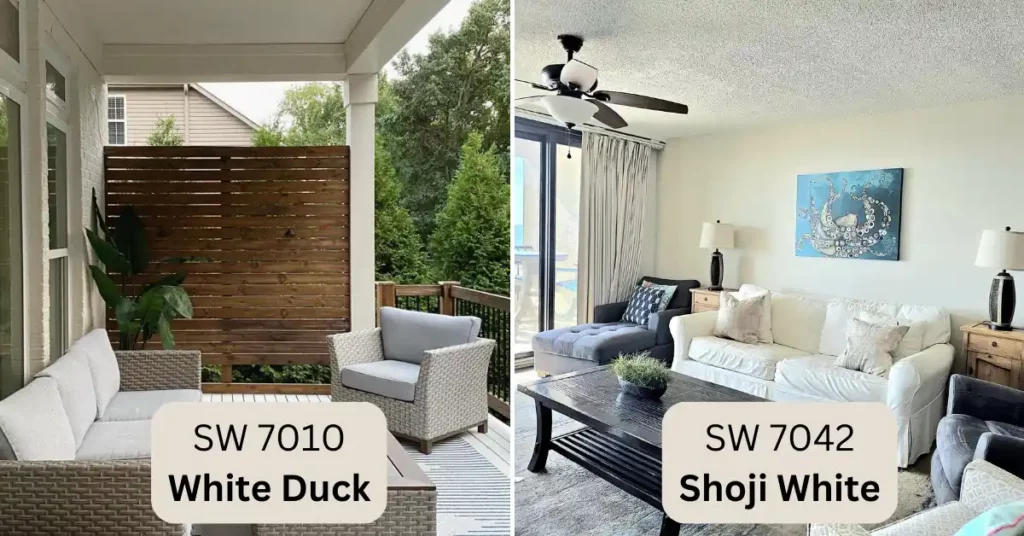White Duck and Shoji White are both popular Sherwin-Williams paint colors. White Duck skews warmer with a greige undertone while Shoji White offers a softer, slightly cooler presence.
Choosing the right white paint can dramatically transform a space, affecting both its aesthetics and ambiance. White Duck and Shoji White stand out as top contenders from the Sherwin-Williams collection, attracting homeowners and designers alike.
Each color exhibits unique characteristics that cater to various design preferences and architectural styles—White Duck exudes a warm, inviting feel, thanks to its greige (a blend of gray and beige) undertone, making it an excellent choice for spaces that require a cozy atmosphere.
Shoji White, on the other hand, delivers a cleaner look with a hint of neutrality, leaning slightly cool yet remaining versatile enough to complement different settings.

When selecting between these two hues, consider the room’s natural light, accompanying decor, and the mood you aim to create. A well-chosen white can unify a design scheme, radiate spaciousness, and provide an elegant backdrop to your living space.
What Are White Duck And Shoji White?
Choosing the right paint color for your space can dramatically transform the look and feel of a room. White Duck and Shoji White are two popular shades offered by reputable paint companies. These subtle nuances of white bring warmth and elegance to any interior, with each providing a unique ambiance. Understanding the characteristics of White Duck and Shoji White will guide design enthusiasts to make an informed decision for their painting projects.
Definition Of White Duck
White Duck Vs White Dove is a soft and sophisticated paint color that strikes a balance between being a warm and cool hue. It has a slight undertone that avoids the starkness associated with pure white, allowing it to blend seamlessly into various design styles. Ideal for creating a tranquil and inviting atmosphere, White Duck adapts to different lighting conditions, subtly shifting its warmth throughout the day.
Definition Of Shoji White
Greek Villa Vs Shoji White is a versatile off-white shade that leans more towards a warm, beige tone. Its understated elegance is attributed to its creamy yet muted hue, which exudes a sense of calm and comfort in a space. Shoji White paints walls with softness and pairs well with an array of colors and materials, making it a favorite among designers for its adaptability and timeless appeal.

Characteristics Of White Duck
When redecorating a room or picking the perfect color for a cozy space, choosing the right white can make all the difference. Among the plethora of shades available, White Duck stands out as a versatile, warm white that brings a gentle elegance and a serene vibe to any setting. In this detailed look into the characteristics of White Duck, we’ll explore its color spectrum, its subtle undertones, and the lighting conditions that bring out its best features.
Color Spectrum
White Duck is a subdued, warm-hued white with a softness that douses spaces in a tranquil glow. Unlike the starkness typical of some whites, White Duck glows with a creamy intensity that elevates it to a sophisticated level. Its adaptability to different styles and environments is one of its strongest assets. On the color spectrum, it lies closer to a natural linen, making it a favorite for designers seeking a white that complements both modern and vintage aesthetics.
Undertones
Undertones matter immensely when picking the perfect paint, and White Duck doesn’t disappoint. The key to its warm, welcoming nature is a beautiful blend of beige and gray undertones that give it a complex but poised character. This carefully balanced combo ensures that it performs magnificently in a variety of interior spaces without veering too yellow or too cool, keeping environments feeling fresh yet cozy.

Ideal Lighting Conditions
The true charm of White Duck comes alive under the right lighting conditions. It thrives in spaces washed in natural light but also holds its own when paired with well-placed artificial lighting. Rooms with southern exposure will highlight its beige tones, enveloping the space in warmth, while northern light accentuates its gray dimensions, offering a crisper finish. Nevertheless, White Duck maintains its calming essence across different lighting scenarios, proving its resilience and versatility as a paint choice.
Characteristics Of Shoji White
Exploring the nuanced palette of neutrals can be both exciting and a bit daunting. Shoji White stands out as a sophisticated shade that embodies a serene and inviting atmosphere. Its subtle warmth and adaptable nature make it a favorite among designers looking to create a space that feels both grounded and airy. In this section, we delve into the distinct Characteristics of Shoji White, providing insights into its color spectrum, undertones, and ideal lighting conditions.
Color Spectrum
Shoji White is part of a color spectrum that strikes the perfect balance between warm and cool tones. Its versatility emerges from being able to blend seamlessly with various color palettes. This attribute renders it an excellent choice for walls, trim, or accent pieces.
Undertones
The nuanced elegance of Shoji White is largely due to its underlying undertones. Unlike the starkness of pure white, Shoji White envelops a room with its soft, creamy undertones. These subtle hints of warmth add depth and complexity to the color, preventing it from feeling sterile or icy.
Ideal Lighting Conditions
Lighting plays a pivotal role in revealing the true essence of Shoji White. Ideally, this hue thrives in spaces bathed in natural light, which accentuates its warm undertones and creamy complexion. Yet, in rooms with limited natural light, artificial lighting with warm bulbs can also complement the color, ensuring spaces feel cozy and welcoming.
White Duck Vs Shoji White: Application In Interior Design
Choosing between White Duck and Shoji White can completely transform the look and feel of a room. These colors, though similar at a glance, hold the potential to infuse spaces with distinct personalities and styles. In the nuanced world of interior design, a shade’s influence extends beyond its initial aesthetic appeal, harmonizing with design elements to create a cohesive look. Let’s explore how White Duck and Shoji White paint colors can be applied to a variety of interior design schemes.

Compatibility With Different Design Styles
White Duck shines in environments where a warm and inviting ambiance is desired. It has a subtle, warm undertone that pairs well with natural materials, like wood and stone. This off-white hue excels in design styles such as:
- Rustic – Complements the organic textures and earthy tones
- Traditional – Enhances the depth of classical trims and moldings
- Modern Farmhouse – Pairs perfectly with shiplap walls and natural fibers
In contrast, Shoji White is the go-to for a crisper look, maintaining a cleaner white while still avoiding starkness. It’s a versatile choice for:
- Scandinavian – Amplifies a minimalist aesthetic with cool, muted tones
- Contemporary – Offers a sleek backdrop for bold modern accents
- Coastal – Evokes a breezy, light atmosphere in tune with sandy hues
Creating Different Moods And Aesthetics
The application of White Duck and Shoji White also has a significant impact on the room’s mood and aesthetic. White Duck, with its warmer qualities, is excellent for creating a cozy and welcoming environment.
It can soften spaces that receive plenty of natural light, preventing a clinical feel and instead, providing a relaxed and soft appearance.
Conversely, Shoji White’s cooler undertones foster a serene and tranquil space. It can make rooms feel more spacious and pure.
Shoji White’s adaptability with different lighting conditions also means it can maintain its intended effect throughout the day without drastic changes, something particularly beneficial in rooms used at all hours.
Both White Duck and Shoji White effortlessly align with varied palettes and textures, influencing the room’s mood accordingly:
| Color | Mood | Aesthetic |
| White Duck | Warm, Cozy | Inviting, Homely |
| Shoji White | Calming, Serene | Crisp, Refined |
The choice between White Duck and Shoji White has a profound impact on the resultant mood and aesthetic of a space.
Whether you aim to achieve a snug retreat or a sleek, modern haven, these hues offer distinct pathways to the desired tone and texture of your home’s interior.
Using White Duck And Shoji White In Different Spaces
Choosing the right white paint for your space can be a transformative experience. White Duck and Shoji White are two such hues that can effectively enhance the ambiance of a room.
As we dive into various spaces within the home, let’s explore how each of these whites can set a distinct mood and create a welcoming atmosphere.

Living Rooms
Living rooms serve as the heart of the home—a place for relaxation and gathering. White Duck, with its warm undertones, exudes a soft, inviting glow. This shade is ideal for spaces with ample sunlight, gracing the walls with a cozy luminosity that complements natural light.
- Layer textures: Combine White Duck with velvety textiles and wooden accents for a comfortable, lived-in look.
- Highlight art: Use it as a backdrop for vivid artwork to really pop against the subtle warmth of this color.
Kitchens
Kitchens, the hub of culinary creativity, demand a backdrop that’s both appetizing and clean. Shoji White stands out as a pristine option. With its neutral stance, It adapts seamlessly to various lighting conditions, maintaining its crisp appearance from dawn till dusk.
- Pair with contrasting cabinetry for a sleek, modern aesthetic.
- Accent with stainless steel appliances for a professional culinary space.
Bedrooms
For bedrooms, a sanctuary for rest, the color palette should evoke tranquility. Here, White Duck softens the room’s aura, creating a tranquil retreat. Its muted warmth is soothing, making it an excellent choice for a restful night.
| White Duck Characteristics | Bedroom Applications |
| Warm Undertones | Accentuates wood furniture and floors |
| Soft Glow | Compliments low, warm lighting for a cozy feel |
Comparative Analysis: White Duck Vs Shoji White
Welcome to our deep dive into the nuanced world of white paint, as we examine White Duck vs. Shoji White. Even the smallest variance in shade can transform a room, making this comparison essential for homeowners, designers, and DIY enthusiasts alike aiming for that perfect palette.
Comparative Analysis: Color Intensity
Comparative Analysis: Color Intensity
Understanding the color intensity of these shades is crucial in determining how they’ll influence your space. White Duck, a warm and soft off-white, provides a comfortable and inviting atmosphere without overwhelming with brightness. On the other hand, Shoji White skews slightly brighter and crisper, reflecting more light and making it a go-to for spaces needing a subtle uplift.
| White Paint | Color Intensity Description |
| White Duck | Muted softness, ideal for relaxed settings |
| Shoji White | Higher brightness, for a sharper ambiance |
Versatility in Design Schemes
Versatility In Design Schemes
The versatility in design schemes offered by White Duck and Shoji White paints is second to none. Each possesses unique qualities adapting beautifully to a range of décor styles. White Duck’s understated elegance fits effortlessly with rustic and vintage motifs, enveloping a room with its warm tones. Whereas, Shoji White is the perfect complement to modern and minimalist designs, aligning with a sleek, contemporary look.
- White Duck excels in:
- Creating a cozy, intimate feel
- Pairing with natural materials like wood and stone
- Shoji White stands out in:
- Enhancing bright, airy spaces
- Marrying well with both warm and cool tones
Tips For Choosing Between White Duck And Shoji White
Deciding on the perfect paint color for your space is a pivotal part of your home’s aesthetic appeal. White Duck and Shoji White are two shades that transcend mere preference, influencing the mood and ambiance of any room. While both offer their unique charm, selecting the right one may not be a straightforward task. To ease the process, here are some insightful tips that will help you make an informed decision between these two popular hues.
Consideration Of Existing Decor
Analyzing your existing decor is essential when choosing between White Duck and Shoji White. White Duck, with its warm undertones, pairs beautifully with earthy components like wooden furniture and natural fibers. In contrast, Shoji White has a slightly cooler undertone, making it perfect alongside contemporary and minimalist designs. Think about the following:
- Furniture pieces: Will they harmonize or stand in stark contrast to the wall color?
- Textiles: Consider the rugs, curtains, and cushions that make up the texture of your room.
- Artwork and accessories: Reflect on how the shades will background your decor.
Remember, the goal is to create a cohesive look that speaks to your style.
Impact Of Natural Light On Color Perception
The amount of natural light a room receives can drastically affect how a paint color is perceived. White Duck can appear warmer and more inviting in spaces flooded with sunlight, while Shoji White might display its cooler notes more prominently. It is crucial to observe your room at different times of the day, assessing how both shades respond to the changing light. Here’s a quick guide:
| Time of Day | White Duck Perception | Shoji White Perception |
| Morning | Gentle, Soft Glow | Crisp, Bright Appearance |
| Afternoon | Warm, Welcoming Tone | Cool, Neutral Look |
| Evening | Cozy, Intimate Feel | Calming, Subdued Shade |
Evaluating how these tones play with light will ensure that you’re never caught off guard by your walls throughout the day. With these considerations in mind, you’re now equipped to decide with confidence between the subtle and serene White Duck and the tranquil yet sophisticated Shoji White for your space.
Conclusion
Choosing between White Duck and Shoji White ultimately depends on your space and lighting. White Duck offers a warmer ambiance, perfect for cozy interiors. Shoji White brings a crisp, clean look that can visually enlarge a room. Consider your decor goals carefully and sample both to find your ideal hue.

S. Pushon is a paint expert, self-taught artist, and currently working as an adviser in the paint industry as a Quality Improvement and Development Assistant.
An artist by heart, he draws remarkable art pieces and as a professional paint industry individual, he seeks the insight and shares with enthusiasts. Read more…

